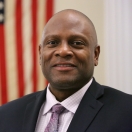
The nation is on track under the updated National HIV/AIDS Strategy to achieve sharp reductions in the transmission of the once-deadly virus in the years ahead—this was just one of the many comments we heard last Wednesday as we celebrated the 25th Anniversary of the Ryan White Comprehensive AIDS Resources Emergency (CARE) Act here at the White House.
The event, entitled Moving Forward with CARE: Building on 25 Years of Passion, Purpose and Excellence, featured Surgeon General Vivek Murthy, Senator Orrin Hatch and former Representative Henry Waxman, co-sponsors of the bill, Senator Joe Donnelly, Dr. Anthony Fauci from NIH, the mother of the young man who inspired the legislation, Jeanne White-Ginder, advocates and Hill staffers from the time of passage, and members of the Ryan White HIV/AIDS Program community, including Federal, academic, and community leaders, and people living with HIV.
Click here to read President Obama’s message recognizing the 25th anniversary.
Enacted on August 18, 1990 – as thousands were dying of the disease – the bipartisan law launched the single largest program providing services to those living with HIV. In the ensuing years, the CARE Act has been a beacon and helped shape the response to HIV-AIDS across continents. Today, more than 500,000 people receive care funded by the Program, administered by the U.S. Department of Health and Human Services, Health Resources and Services Administration (HRSA)—and it’s been reauthorized four times over successive administrations.
A lot has changed in 25 years. Twenty-five years ago, we had little hope. Now, hope prevails. Not only do we know how to prevent the disease, but we know how to treat it. The Ryan White HIV/AIDS Program has been, and continues to be, critical in getting people that treatment, helping them live long, healthy lives that we once thought impossible.
Clinics funded by the Ryan White HIV/AIDS Program now are retaining more than 8 out of 10 patients in care – and very nearly as many have successfully achieved “viral suppression,” significantly reducing their risk of transmitting HIV. This is extraordinary, especially compared to the much lower national rates of retention in care and viral suppression.
And while challenges remain with the HIV epidemic – nearly 13 percent of those infected with HIV don’t know it, and there are 50,000 new infections annually -- the trajectory of the disease suggests that an end to the pandemic is in sight.
There’s no doubt that a large part of this is due to the Ryan White HIV/AIDS Program. So we continue to celebrate.
BACKGROUND ON THE RYAN WHITE CARE ACT
The law was named for the Indiana teenager who was shunned in his school and community after becoming infected while being treated for hemophilia in 1984. Ryan White went on to become the face of a movement and a law that changed American history and how HIV/AIDS was viewed around the world.
Once a typical, Midwestern teenager with an affinity for skateboarding, toy cars, and comic books who ‘just wanted to be a kid,’ Ryan White is now considered a genuine American hero whose story has changed the lives of millions.
His impact on HIV/AIDS care continues to resonate across populations and has become global in scope since his death on April 8, 1990. Because of the Ryan White CARE Act, life-changing care and supportive services are now available that were once unknown at the height of the scourge.
Expelled in 1984 from his school in Kokomo, Indiana over the objection of public health experts who said he posed no risk to his peers, the 13-year-old faced discrimination so intense that his family was forced to move. Doctors initially gave White three to six months to live.
He survived for 5½ years, testifying at age 16 before the Presidential Commission on AIDS; discussing HIV in an address to 10,000 teachers and educators in the Louisiana Superdome; joining an Oscar party hosted by President Reagan and becoming the recognized face of the HIV epidemic in America.
Jeanne White-Ginder, Ryan White’s mom, traveled to Washington just two weeks after Ryan’s death to urge passage of the legislation named for her son. And after passing both the House and Senate, on August 18, the bill was signed into law by President George H. W. Bush– creating the Ryan White HIV/AIDS Program. HRSA quickly put in place the mechanisms needed to administer the new law, uniting governments, provider, and entire communities and distributed the Program’s first grants in April 1991.
Douglas M. Brooks, MSW is the Director of the Office of National AIDS Policy.
Laura Cheever, MD, ScM is HRSA’s Associate Administrator for the HIV/AIDS Bureau.


